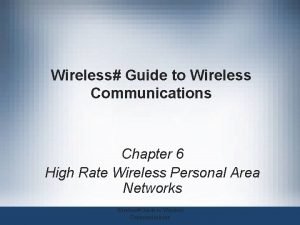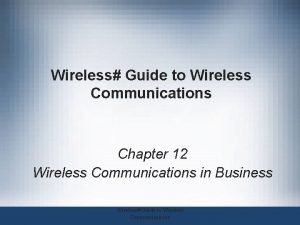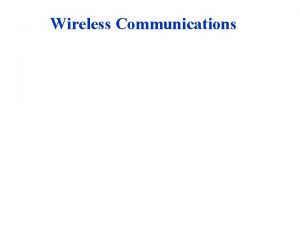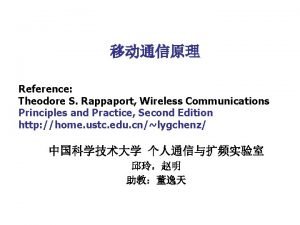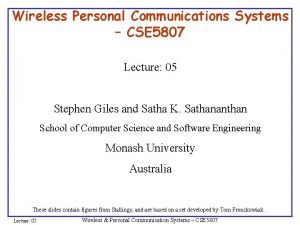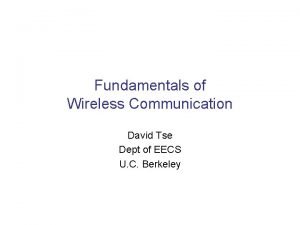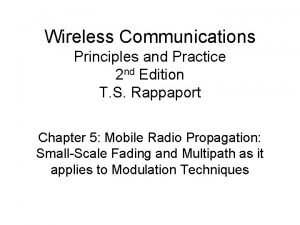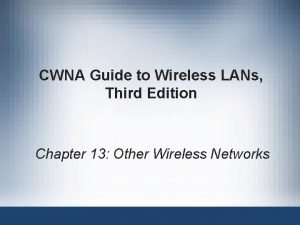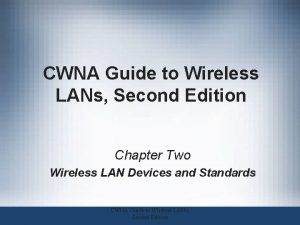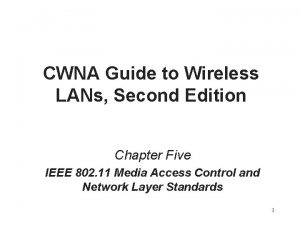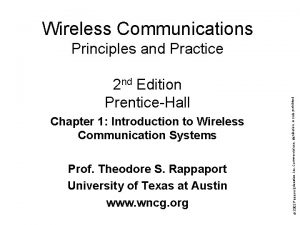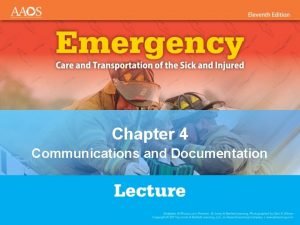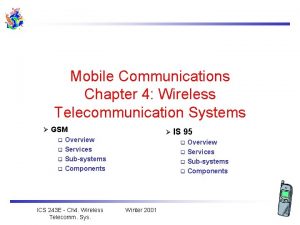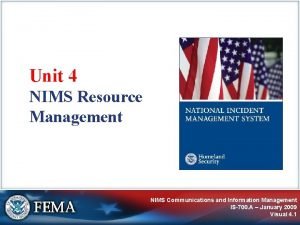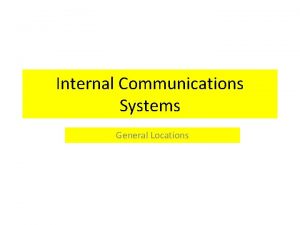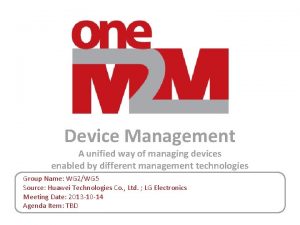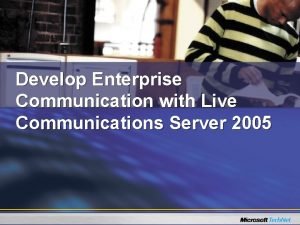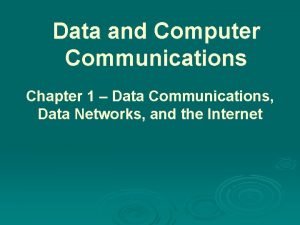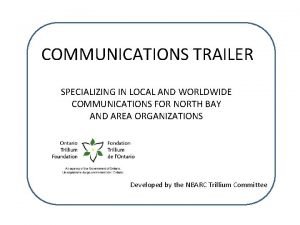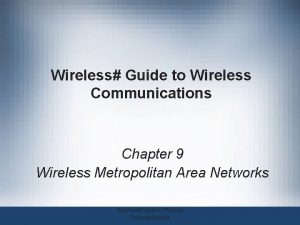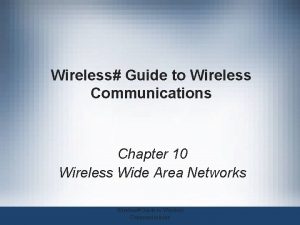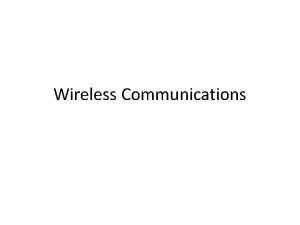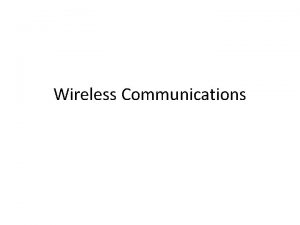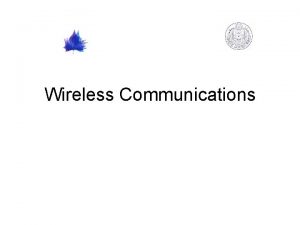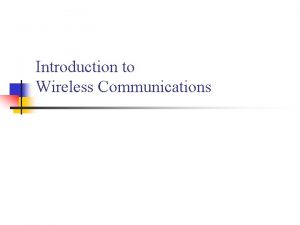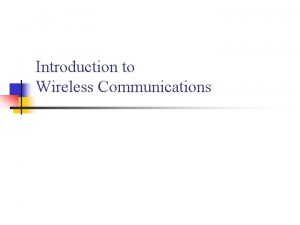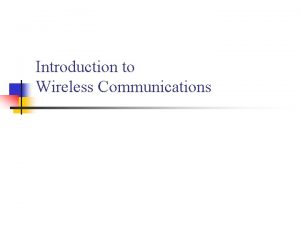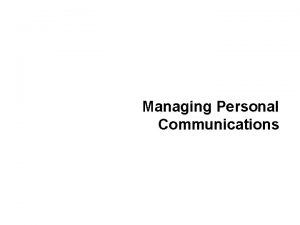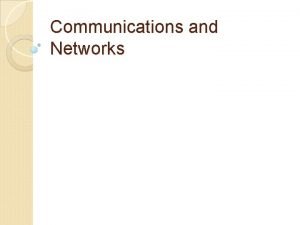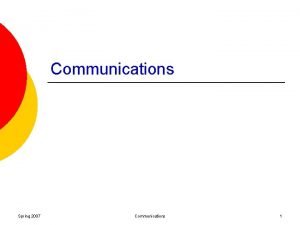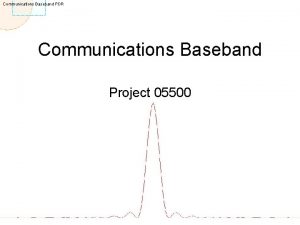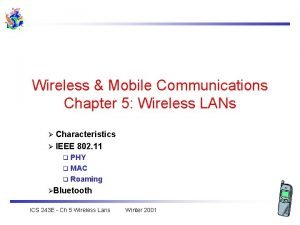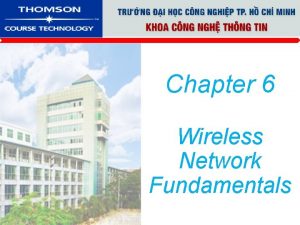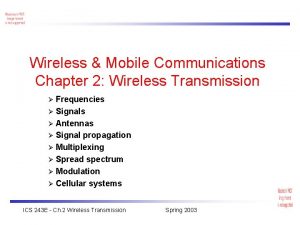Wireless Guide to Wireless Communications Chapter 1 Introduction























































- Slides: 55

Wireless# Guide to Wireless Communications Chapter 1 Introduction to Wireless Communications Wireless# Guide to Wireless Communications

Objectives • Explain how the major wireless technologies are used today • Describe various applications of wireless communications technology • Explain the advantages and disadvantages of wireless communications technology • List several different wireless technologies Wireless# Guide to Wireless Communications 2

How Wireless Technology is Used • Wireless – Describes devices and technologies that are not connected by a wire • Wireless communications – Transmission of user data without the use of wires • Wireless data communications technologies include: – – Bluetooth Wireless LAN and WAN Satellite Cellular Wireless# Guide to Wireless Communications 3

A Wireless World • Wireless devices – Distance: 300 feet (90 meters) – Bandwidth: 54 Mbps – Can also include Voice over IP (Vo. IP) • Wireless network interface card (Wireless NIC) – Sends and receives data over radio waves • Smartphone – Combination mobile phone and personal digital assistant (PDA) Wireless# Guide to Wireless Communications 4

A Wireless World (continued) Wireless# Guide to Wireless Communications 5

Bluetooth and Ultra Wide Band • Radio frequency identification device (RFID) tags – Small chips containing radio transponders • Can be used to track inventory • Bluetooth and Ultra Wide Band (UWB) – Wireless standards designed for very short ranges – Communicate using small, low-power transceivers • Link manager – Special software that helps identify other Bluetooth devices Wireless# Guide to Wireless Communications 6

Bluetooth and Ultra Wide Band (continued) Wireless# Guide to Wireless Communications 7

Bluetooth and Ultra Wide Band (continued) • Bluetooth – Distance: up to 33 feet (10 meters) – Bandwidth: 1 Mbps • Ultra Wide Band – Distance: 150 feet (50 meters) – Bandwidth: 100 Mbps to 2 Gbps • Piconet – Wireless personal area network (WPAN) – Consists of two or more Bluetooth devices that are exchanging data with each other Wireless# Guide to Wireless Communications 8

Bluetooth and Ultra Wide Band (continued) Wireless# Guide to Wireless Communications 9

Satellite Networks • Used to transmit data over very long distance • Repeater – Located in the satellite itself – Simply “repeats” the same signal to another location – Used to transmit data from one earth station to another • Transmission time is approximately 250 milliseconds Wireless# Guide to Wireless Communications 10

Satellite Networks (continued) Wireless# Guide to Wireless Communications 11

Satellite Networks (continued) Wireless# Guide to Wireless Communications 12

Cellular Networks • Modern cellular telephone network – Built around the concept of low power transmitters – With each “cell” handling a number of users – Transmission towers are spread throughout a geographical area – The same radio frequency channels can be reused by another tower • Located a few miles away to avoid interference • Maximizes the use of a limited range of frequency channels Wireless# Guide to Wireless Communications 13

Cellular Networks (continued) Wireless# Guide to Wireless Communications 14

Cellular Networks (continued) • 3 G (third generation) technology – Uses 100% digital transmission for both voice and data – Transmission speed • Up to 2 Mbps when stationary • 384 Kbps for slow-moving pedestrians • Up to 144 Kbps from a moving vehicle • 2. 5 G has a maximum data transmission rate of up to 384 Kbps Wireless# Guide to Wireless Communications 15

Cellular Networks (continued) Wireless# Guide to Wireless Communications 16

Wireless Local Area Networks • Wireless Local Area Network (WLAN) – Extension of a wired LAN • Connecting to it through a device called a wireless access point • Access point (AP) – Relays data signals between all of the devices in the network • Each computer on the WLAN has a wireless network interface card (NIC) – With an antenna built into it Wireless# Guide to Wireless Communications 17

Wireless Local Area Networks (continued) Wireless# Guide to Wireless Communications 18

Wireless Local Area Networks (continued) • Institute of Electrical and Electronic Engineers (IEEE) standards – 802. 11 a, 802. 11 b, and 802. 11 g Wireless# Guide to Wireless Communications 19

Wireless Local Area Networks (continued) Wireless# Guide to Wireless Communications 20

Wireless Local Area Networks (continued) Wireless# Guide to Wireless Communications 21

Wireless Local Area Networks (continued) Wireless# Guide to Wireless Communications 22

Fixed Broadband Wireless • Integrated Services Digital Networks (ISDN) – Transmit at 256 Kbps over regular phone lines • T 1 lines – Transmit at 1. 544 Mbps • Cable modems and digital subscriber lines (DSL) – Generally only available in residential areas – Maximum transmission speed is only about 8 Mbps Wireless# Guide to Wireless Communications 23

Fixed Broadband Wireless (continued) • Wireless metropolitan area network (WMAN) – Covers a distance of up to 35 miles – Based on the IEEE 802. 16 Fixed Broadband Wireless standard – Uses small custom antennas on the roof of each building – Transmission speeds • 75 Mbps at distances of up to 4 miles (6. 4 km) • 17 to 50 Mbps at distances over 6 miles (10 km) Wireless# Guide to Wireless Communications 24

Fixed Broadband Wireless (continued) Wireless# Guide to Wireless Communications 25

Wireless Wide Area Network • Hypertext Markup Language (HTML) – Standard language for displaying content from the Internet • Microbrowser – Miniaturized version of a Web browser • Wireless Application Protocol version 2. 0 (WAP 2) – Provides a standard way to transmit, format, and display Internet data • For small wireless devices such as cell phones Wireless# Guide to Wireless Communications 26

Wireless Wide Area Network (continued) Wireless# Guide to Wireless Communications 27

Wireless Wide Area Network (continued) • Programming languages – BREW (Binary Run-Time Environment for Wireless) – J 2 ME (Java 2 Micro Edition) • Wireless Wide Area Network (WWAN) – Enables employees to access corporate data and applications from virtually anywhere Wireless# Guide to Wireless Communications 28

Wireless Wide Area Network (continued) Wireless# Guide to Wireless Communications 29

Older Wireless Technologies • Shared Wireless Access Protocol (SWAP) – Set of specifications for wireless data and voice communications around the home – Distance: 150 feet (45 meters) – Transmission speed: up to 10 Mbps – Includes not only computer equipment but also cordless telephones and home entertainment equipment – Established by the Home. RF Working Group Wireless# Guide to Wireless Communications 30

The Wireless Landscape • Wireless communications – Has become a standard means of communication for people in many occupations and circumstances Wireless# Guide to Wireless Communications 31

The Wireless Landscape (continued) Wireless# Guide to Wireless Communications 32

The Wireless Landscape (continued) Wireless# Guide to Wireless Communications 33

Digital Convergence • Digital convergence – Refers to the power of digital devices to combine voice, video, and text processing capabilities • As well as to be connected to business and home networks and to the Internet Wireless# Guide to Wireless Communications 34

Wireless Applications • Main areas – – – – – Education Home entertainment Health Care Government and Military Office environments Event management Travel Construction and warehouse management Environmental research Industrial control Wireless# Guide to Wireless Communications 35

Education • Ideal application for colleges and schools • It frees students from having to go to a specific computer lab or the library – To get on the school’s computer network • Wireless technology translates into a cost savings for colleges as well Wireless# Guide to Wireless Communications 36

Home Entertainment • Wireless communication – Enables movie and audio enthusiasts to download, distribute, and control all forms of digital entertainment from anywhere in the house Wireless# Guide to Wireless Communications 37

Health Care • Administering medication in a hospital setting – A major problem area for the health care industry • Wireless point-of-care computer systems – Allow medical staff to access and update patient records immediately • Even telephones are now being connected to hospital IEEE 802. 11 WLANs – Employing Vo. IP technology Wireless# Guide to Wireless Communications 38

Government • Wireless communication – Lets city employees and contractors at remote sites access data stored in a central database – Delivers broadband connectivity to schools, libraries, and government buildings – Provides free Internet access to residents and attracts visitors and businesspeople Wireless# Guide to Wireless Communications 39

Military • Universal Handset – A 1. 5 -pound device – Allows military personnel in the field to communicate through a variety of methods • Using wireless technologies – Military is currently working on preventing enemies from eavesdropping on or jamming the signal Wireless# Guide to Wireless Communications 40

Office Environments • Employees in all lines of work no longer have to be away from the data they need – To help them make decisions • Wireless technologies allow businesses to create an office – Where the traditional infrastructure doesn’t already exist Wireless# Guide to Wireless Communications 41

Event Management • Wireless networks – Help identify a stolen or counterfeit ticket – Can also give a real-time look at traffic flow – In-progress game statistics are available to any fan in the stadium with a wireless device Wireless# Guide to Wireless Communications 42

Travel • Wireless global positioning systems (GPS) – Tie into emergency roadside assistance services • Satellite radio – Transmits over 150 music and talk stations • Airport terminals are likewise turning to wireless technologies • Airplanes themselves are being equipped with wireless data access Wireless# Guide to Wireless Communications 43

Construction • Wireless communications – Send information from the job site to the main office – Alert when maintenance operations need to be performed on equipment Wireless# Guide to Wireless Communications 44

Warehouse Management • Implementing wireless technology is key for many warehouse operations • Warehouse management system (WMS) software – Used to manage all of the activities from receiving through shipping • In the near future – Most of the bar code functions, including inventory counting, will be replaced by RFID tags Wireless# Guide to Wireless Communications 45

Environmental Research • Scientists are now using small, battery- or solar-cellpowered WLAN sensors – In places that were previously difficult to access and monitor Wireless# Guide to Wireless Communications 46

Industrial Control • Motes – Remote sensors – Can connect to a WLAN • Then collect data and transmit it to a central location Wireless# Guide to Wireless Communications 47

Wireless Advantages and Disadvantages • As with any new technology, wireless communications offers both advantages and disadvantages Wireless# Guide to Wireless Communications 48

Advantages of Wireless Networking • Mobility – Freedom to move about without being tethered by wires – Permits many industries to shift toward an increasingly mobile workforce – Gives team-based workers the ability to access the network resources • Easier and less expensive installation – Installing network cabling in older buildings can be a difficult, slow, and costly task – Makes it easier for any office to be modified with new cubicles or furniture Wireless# Guide to Wireless Communications 49

Advantages of Wireless Networking (continued) • Increased reliability – Network cable failures may be the most common source of network problems • Disaster recovery – In the event of a disaster, managers can quickly relocate the office Wireless# Guide to Wireless Communications 50

Disadvantages of Wireless Networking • Radio signal interference – The potential for two types of signal interference exists • Security – It is possible for an intruder to be lurking outdoors with a notebook computer and wireless NIC • With the intent of intercepting the signals from a nearby wireless network – Some wireless technologies can provide added levels of security Wireless# Guide to Wireless Communications 51

Disadvantages of Wireless Networking (continued) • Health risks – High levels of RF can produce biological damage through heating effects • Wireless devices emit low levels of RF while being used Wireless# Guide to Wireless Communications 52

Summary • Wireless communications have become commonplace • Wireless networks and devices are found in all circles of life today • Wireless wide area networks will enable companies of all sizes to interconnect their offices – Without the high cost charged by telephone carriers for their landline connections • WLAN applications are found in a wide variety of industries and organizations Wireless# Guide to Wireless Communications 53

Summary (continued) • Remote sensors – Capable of communicating using wireless technologies – Used in large manufacturing facilities • To monitor equipment and for scientific research • Wireless communication advantages – – Mobility Easier and less expensive installation Increased network reliability Support for disaster recovery Wireless# Guide to Wireless Communications 54

Summary (continued) • Wireless communication disadvantages – Radio signal interference – Security issues – Health risks Wireless# Guide to Wireless Communications 55
 Guide to wireless communications
Guide to wireless communications Guide to wireless communications
Guide to wireless communications Constrained nodes and constrained networks
Constrained nodes and constrained networks Subsea wireless communications
Subsea wireless communications Theodore s rappaport wireless communications
Theodore s rappaport wireless communications Wireless personal communications
Wireless personal communications Fundamental of wireless communication
Fundamental of wireless communication Sircim
Sircim Telecommunications, the internet, and wireless technology
Telecommunications, the internet, and wireless technology Cwna guide to wireless lans 3rd edition
Cwna guide to wireless lans 3rd edition Cwna guide to wireless lans
Cwna guide to wireless lans Cwna guide to wireless lans
Cwna guide to wireless lans Introduction to data communications
Introduction to data communications Introduction to data communications and networking
Introduction to data communications and networking Wireless communication introduction
Wireless communication introduction Wireless electricity
Wireless electricity A fire department communication center functions
A fire department communication center functions Chapter 4 communications and documentation
Chapter 4 communications and documentation Communications chapter
Communications chapter Chapter 3 network protocols and communications
Chapter 3 network protocols and communications Guide entretien exemple
Guide entretien exemple Https://www.arduino.cc/en/guide/introduction
Https://www.arduino.cc/en/guide/introduction Https://www.arduino.cc/en/guide/introduction
Https://www.arduino.cc/en/guide/introduction Crisis communication working group
Crisis communication working group Times fiber communications
Times fiber communications Nims communications and information management
Nims communications and information management Telecommunications and data communications
Telecommunications and data communications Perform voice communications blc
Perform voice communications blc Perform voice communications army powerpoint
Perform voice communications army powerpoint Communications mix
Communications mix Subscription management oracle
Subscription management oracle Open source unified communication
Open source unified communication Open platform communications unified architecture
Open platform communications unified architecture Who are puma unified communications
Who are puma unified communications Ministry of transport, communications and works
Ministry of transport, communications and works Bioinformatics toolbox matlab
Bioinformatics toolbox matlab The source or sender of an advertising communication
The source or sender of an advertising communication Objectives of marketing communication
Objectives of marketing communication Push pull profile strategies marketing communications
Push pull profile strategies marketing communications Utility communications market analysis
Utility communications market analysis Internal communications system
Internal communications system Communication mix
Communication mix Btl communications
Btl communications Asterisk open source technology
Asterisk open source technology Integrated marketing communications definition
Integrated marketing communications definition Idaho state communications
Idaho state communications Slappey communications
Slappey communications Global marketing and communications
Global marketing and communications Employee relations communications
Employee relations communications Device management unified communications
Device management unified communications Live communications server
Live communications server Data and computer communications 10th edition
Data and computer communications 10th edition Data & computer communications
Data & computer communications Crisis communication lecture
Crisis communication lecture Ksa crisis communications
Ksa crisis communications Ham radio communications trailers
Ham radio communications trailers
